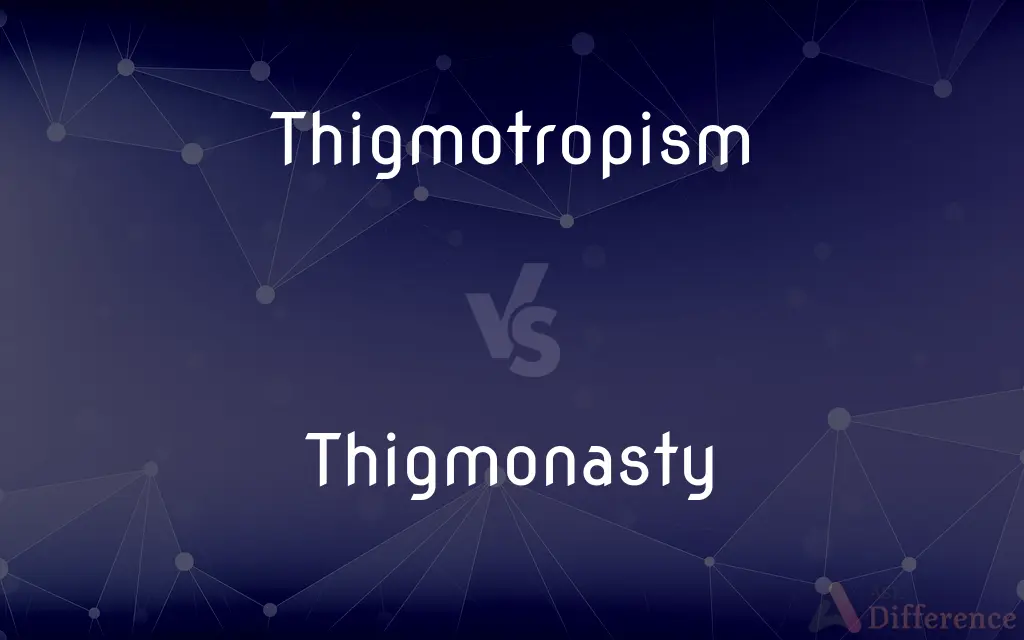Thigmotropism vs. Thigmonasty — What's the Difference?
Edited by Tayyaba Rehman — By Maham Liaqat — Updated on April 15, 2024
Thigmotropism involves directional growth responses in plants to touch stimuli, focusing on long-term structural changes, whereas thigmonasty triggers rapid, non-directional movements in response to touch.

Difference Between Thigmotropism and Thigmonasty
Table of Contents
ADVERTISEMENT
Key Differences
Thigmotropism is observed when plants exhibit growth towards or away from a mechanical stimulus, such as a vine curling around a support, while thigmonasty involves quick, temporary movements, as seen when a Venus flytrap snaps shut.
In thigmotropism, the growth response is directional and dependent on the stimulus's location, enabling plants like climbing vines to grasp structures; whereas in thigmonasty, the movement is non-directional, typically occurring uniformly in all directions affected by the stimulus.
Thigmotropism results in permanent structural changes in a plant, adjusting its growth pattern over time to optimize support and sunlight exposure, while thigmonasty results in rapid, often reversible actions meant for defense or to capture prey.
The mechanisms of thigmotropism involve slower hormone redistributions, particularly auxin, which promotes growth on the side of the stem away from the stimulus; on the other hand, thigmonasty often uses quick electrical and chemical signals to facilitate immediate movement.
While thigmotropism supports long-term survival and adaptability by enhancing access to necessary resources, thigmonasty primarily serves as a protective or predatory mechanism, offering immediate responses to external threats or opportunities.
ADVERTISEMENT
Comparison Chart
Response Type
Directional growth response
Rapid, non-directional movement
Duration
Long-term structural change
Short-term, often reversible
Mechanism
Hormonal changes (e.g., auxin redistribution)
Electrical and chemical signals
Purpose
Support climbing, enhance resource access
Defense, prey capture
Dependency
Dependent on the location of the stimulus
Non-dependent on stimulus location
Compare with Definitions
Thigmotropism
A plant's growth response directed by touch.
A cucumber vine exhibits thigmotropism by curling around a trellis.
Thigmonasty
Independent of the direction of stimulus.
Thigmonasty occurs uniformly regardless of where the plant is touched.
Thigmotropism
Enhances survival and structural stability.
Ivy uses thigmotropism to climb and anchor itself securely on surfaces.
Thigmonasty
Serves protective or predatory functions.
Thigmonasty in carnivorous plants aids in trapping prey quickly.
Thigmotropism
Involves slow, purposeful adjustments.
Thigmotropism allows plants to explore and optimize their physical positioning.
Thigmonasty
Relies on electrical and chemical triggers.
Rapid ion fluxes trigger the thigmonastic movements in sensitive plants.
Thigmotropism
Dependent on stimulus direction.
Roots show thigmotropism by growing away from obstructions.
Thigmonasty
A rapid movement in plants triggered by touch.
The Mimosa pudica folds its leaves in response to touch, showcasing thigmonasty.
Thigmotropism
Facilitated by hormonal changes.
The redistribution of auxin in response to touch exemplifies thigmotropism in action.
Thigmonasty
Characterized by quick, temporary actions.
Thigmonasty in Venus flytraps allows for swift closure on insects.
Thigmotropism
Thigmotropism is a directional growth movement which occurs as a mechanosensory response to a touch stimulus. Thigmotropism is typically found in twining plants and tendrils, however plant biologists have also found thigmotropic responses in flowering plants and fungi.
Thigmonasty
Thigmonasty or seismonasty is the nastic response of a plant or fungus to touch or vibration. Conspicuous examples of thigmonasty include many species in the leguminous subfamily Mimosoideae, active carnivorous plants such as Dionaea and a wide range of pollination mechanisms.
Thigmotropism
The movement or growth of an organism in a particular direction in response to contact with a solid object.
Thigmonasty
A nastic response to touch or vibration.
Thigmotropism
(biology) Growth or motion in response to touch
Common Curiosities
What is thigmonasty?
Thigmonasty refers to rapid, non-directional movements in plants triggered by touch.
What is thigmotropism?
Thigmotropism is a plant's growth response to touch, resulting in movement towards or away from a stimulus.
What hormonal changes support thigmotropism?
Hormonal changes like auxin redistribution facilitate thigmotropism.
Can a plant exhibit both thigmotropism and thigmonasty?
Yes, some plants can exhibit both, utilizing thigmotropism for growth and thigmonasty for rapid responses.
How do thigmotropism and thigmonasty affect plant survival?
Thigmotropism enhances long-term survival by improving structural stability and access to resources, while thigmonasty offers immediate defense or feeding mechanisms.
How do thigmotropism and thigmonasty differ in purpose?
Thigmotropism aids in structural support and resource acquisition, while thigmonasty serves for defense or prey capture.
What triggers thigmotropism in plants?
Thigmotropism is triggered by physical touch and is dependent on the location of the stimulus.
What are typical examples of thigmotropism and thigmonasty in plants?
Typical examples include climbing vines for thigmotropism and Venus flytraps for thigmonasty.
How fast does thigmonasty occur in plants?
Thigmonasty occurs almost immediately after the plant perceives a touch.
What electrical changes are involved in thigmonasty?
Rapid ion fluxes across cell membranes are involved in thigmonasty.
Share Your Discovery

Previous Comparison
Tachycardia vs. Bradycardia
Next Comparison
Plot vs. ThemeAuthor Spotlight
Written by
Maham LiaqatEdited by
Tayyaba RehmanTayyaba Rehman is a distinguished writer, currently serving as a primary contributor to askdifference.com. As a researcher in semantics and etymology, Tayyaba's passion for the complexity of languages and their distinctions has found a perfect home on the platform. Tayyaba delves into the intricacies of language, distinguishing between commonly confused words and phrases, thereby providing clarity for readers worldwide.
















































